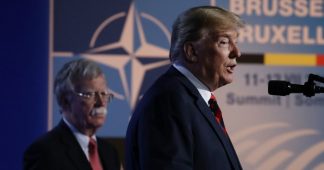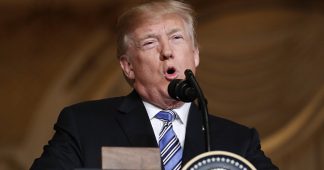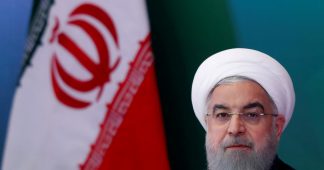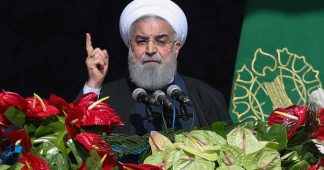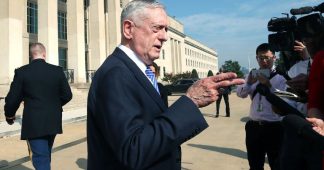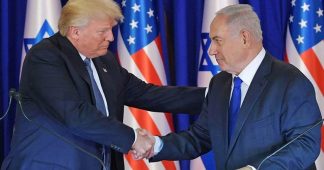The world of the terrifying hypothetical is programmatically standard in the Trump White House. Periods of tense calm are followed by careless flights of fury, digs and remonstrations. Mortal enemies become amenable comrades; reliable allies turn into irresponsible skinflints who ought to fork our more for their defence.
For all that swirling chaos, the one constant since the 2016 election campaign for President Donald Trump is the Iranian bogey, that defender of the Shiites, the theocratic Republic. The fear of Iran’s aspirations is an endless quarry for domestic consumption, tied, as it were with propitiating the ever hungry Israeli Prime Minister Benjamin Netanyahu.
On July 23, Trump gave a Twitter offering to Iranian President Rouhani, written in all-caps promising singular, untold of consequences of suffering should Iran ever threaten the United States again. “We are no longer a country that will stand for your demented words of violence and death. Be cautious!”
This shout of indignation was the less than measured response to remarks made by Rouhani to Iranian diplomats: “America should know that peace with Iran is the mother of all peace and war with Iran is the mother of all wars.”
After the outburst came the milder reflection. Before a convention in Kansas City, a cooling breeze was blowing. “I withdrew the United States from the horrible one-sided Iran nuclear deal, and Iran is not the same country anymore,” came Trump’s explanation. The United States was “ready to make a deal.”
This picture of dysfunctional play was further clouded by last week’s ominous revelations from Australia’s national broadcaster, the ABC. The network had received some troubling titbits of information suggesting that the United States is intending to launch strikes on Iran’s nuclear facilities next month. This has also prompted concerns about how broad the remit will be. Which allies will be called upon to be engaged in an endeavour that seems more than mildly suicidal?
One unnamed security source described in exasperating fashion by the ABC as “senior” suggests that Australia is supplying aspects of the skeletal outline for such a strike, specifically in the realm of identifying targets: “Providing intelligence and understanding as to what is happening on the ground so that the Government and allied governments are fully informed to make decisions is different to active targeting.”
This willing source within the Turnbull government was adamant to draw distinctions between the actual strike itself (described as the “kinetic” mission), and sketching the picture itself. “Developing a picture is very different to actually participating in a strike.”
But Australia would be implicated in such a mission, should it ever get off the ground, given the role played by the misnamed joint-defence facility at Pine Gap, located in central Australia. The virtually unknown Australian Geospatial-Intelligence Organisation would also do its bit.
As with any such reports emerging either within the White House, or from its imperial periphery, signals vary. The US Defence Secretary John Mattis, just to make things a touch more interesting, described the reports as lacings of fantasy. “I have no idea where the Australian news people got that information. I’m confident it is not something that’s being considered right now and I think it’s a complete, frankly, it’s fiction.”
The subsequent response from the Australian Prime Minister was an unsurprising, vassal phrased echo. “President Trump has made his views very clear to the whole word, but this story,” noted Malcolm Turnbull, “has not benefited from any consultation with me, the Foreign Minister, the Defence Minister or the Chief of the Defence force”. This, on paper, looks like a decidedly appropriate Trump formula: avoid consultation; it might just cloud your judgment.
The detail supplied to the ABC over the strike plans should not be sneezed at. Given Trump’s belligerent inner circle (Secretary of State Mike Pompeo and National Security Advisor John Bolton) steaming with the anticipation of a first strike against irreverent states, and the promptings of Israel, the issue retains an air of solemn seriousness. Even a more moderate Mattis is ever keen to run a grocer’s list of sins perpetrated by Teheran: bolstering Bashar al-Assad in Syria, “fomenting more violence” in Yemen, Iran as regional bully.
The prospect of strikes on Iranian facilities has been further complicated by public enunciations from Netanyahu reiterating the Begin Doctrine, stressing that, “Israel will not allow regimes that seek our annihilation to acquire nuclear weapons”. The danger here, as ever, is that Israel will go rogue and initiate such an attack, though the spread of Iran’s facilities complicates any such enterprise.
Clio is a cruelly dogged taskmaster and a refusal to listen to the echoes of warnings she inspires imperils states and their citizens. Invading, interfering and altering the trajectory of development in the Middle East tends to have global repercussions. Western states have shown a pigheadedly dangerous tendency to meddle and destroy. Death inevitably follows; vacuums are created. These latest slivers of information from Canberra on US intentions is a salutary reminder that much has not changed.
